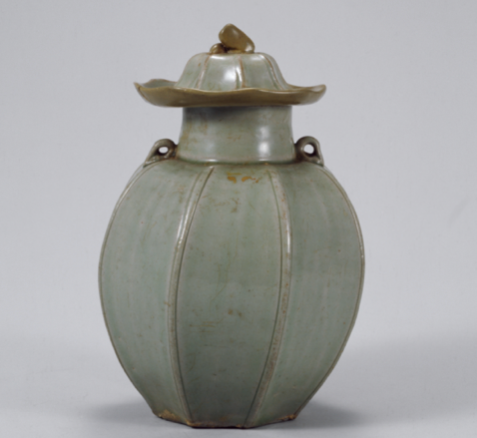











Yoseka Ceramics Ink Series - Tang Mi Se Blue
- Regular price
- $20.00
- Sale price
- $20.00
- Regular price
-
- Unit price
- / per
Produced in collaboration with Ink Institute and ceramic artist Li Yan Xun, our Yoseka Ceramics Ink Series showcases 8 unique colors inspired by ceramic glazes from the Yuan, Ming, Tang, Qing, and Song Dynasties, spanning 10 centuries of Chinese color and history. We worked closely with Li to select these 8 colors from his Yan Cai color project, in which he used chemical experimentation to revive the formulas of over 60 historical glazes, to represent the brilliant and splendid history of Chinese ceramics.
The porcelain industry reached its height during the Tang Dynasty (618-907), which was best known for “blue-and-white” wares — fine Persian cobalt met ice-white Chinese pottery in high-temperature fires to produce porcelain in this iconic tradition. In the southern Zhejiang province, a type of ceramic called Yue-ware celadon was particularly popular. This type of porcelain was often praised in the poetry of the time; for example, writer and tea master Lu Yu likened Yue ware celadon to both jade and ice in his monograph “The Classic of Tea” [茶经] (780 AD). These celadon pieces were also called mi se ci, or “secret color porcelain,” a poetic description of the subtlety and nuance of the color.
This “secret” blue-green glaze is quiet and elegant. It evokes the saying: “when the wind blows and the dew thickens in the late autumn, the Yue ware kiln opens up and wins a pool of lush.” (Lu Guimeng, “Secret Color Yue Ware”)

Yue-ware eight-ridged lotus leaf lidded jar (ca. Song Dynasty [960-1279])
National Museum of Korea, Seoul, Korea
- Tang Mi Se Blue (唐代秘色青) – grey-green with hints of blue
- 30ml
- Dye-based
- A portion of the proceeds from the sale of Yoseka Ceramics Inks will fund the Yanshan Art Museum to support the work of Li Yan Xun
- Available as Ink Sample - Yoseka Ceramics
- More Yoseka Ceramics Inks
- More Yoseka Special Projects
About Li Yanxun: Li Yan Xun is a ceramic artist and the founder of the Yanshan Art Museum in Jingdezhen, China. Hailing from a family of ceramic artists, he received formal training at the renowned Jingdezhen Ceramic Institute before starting his own ceramics studio. In addition to inheriting the “watercolor glaze” techniques pioneered by his father, Li Xiaocong, Li Yan Xun spent almost a decade researching and cataloguing the glaze pigments used in Jingdezhen during the Ming and Qing Dynasties. Experimenting with chemical methods like glaze reduction tests and pure reagent analyses, he revived more than 60 historic glazes and documented each formula. Through this color project, titled Yan Cai, Li pursues the notion that an artist can be involved in every phase of their art-making process, from the development of the medium, to the physical craftsmanship, to the firing and completion of the object.






This is beautiful ink! It's low-key one of the reasons I bought a fountain pen as a celadon-ware and stationery enthusiast. I'm newer to fountain pens, so I can't speak as eloquently about the writing experience (pretty great, in my opinion), but the color is fantastic; it absolutely does justice to the glaze. 10/10 I can't wait until they restock—I'm almost out of my sample!
A little fact about myself is that I LOVE the color green. Any green. When I saw this ink, I knew I had to purchase.
The packaging when you get it, is a soft textured box with a label that clearly shows the inspiration and color of the ink. The ink is in a classic Ceramics ink bottle.
The beauty is on the inside. I paired this ink with my TWSBI Jade, and any nib size from the extra fine to the 1.1 stub show the shading of this ink. When wet, the ink shows a copper-blue/green, but when dry, is a jade like green. At one point my pen burped, and ink had gotten all over the page, but even the droplets show the unique color so well.
If you use a Hobonichi or any book with thin, Tomoe River 52 GSM paper, the ink dries well, and doesn't smear if you use a fine nib. I'm not sure about broader nibs, since I mainly use the ink to journal in my Hobonichi Cousin. Overall, I am quite satisfied with my purchase, and if they call for last stock, I'm certainly restocking.
The green ink matches very well with Sailor Dragon Palace Fountain Pen. Love it!!!
I'm actually just bought a second bottle of this just to make sure I always have one available. It's such a great and unique color. Great job on these ceramics inks
So happy I purchased this ink, I love how unique the color is and pairs wonderfully with my many "Jade" themed fountain pens.
